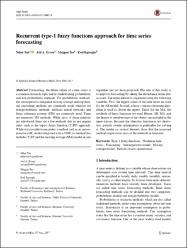| dc.contributor.author | Tak, Nihat | |
| dc.contributor.author | Atıf, Evren | |
| dc.contributor.author | Müjgan, Tez | |
| dc.contributor.author | Erol, Eğrioğlu | |
| dc.date | 2019-07-07 | |
| dc.date.accessioned | 2019-07-08T07:52:03Z | |
| dc.date.available | 2019-07-08T07:52:03Z | |
| dc.date.issued | 2017-05-17 | |
| dc.identifier.citation | Tak, N., Evren, A.A., Tez, M. et al. Appl Intell (2018) 48: 68. https://doi.org/10.1007/s10489-017-0962-8 | |
| dc.identifier.uri | https://hdl.handle.net/20.500.11857/1051 | |
| dc.identifier.uri | https://doi.org/10.1007/s10489-017-0962-8 | |
| dc.description.abstract | Forecasting the future values of a time series is a common research topic and is studied using probabilistic and non-probabilistic methods. For probabilistic methods, the autoregressive integrated moving average and exponential smoothing methods are commonly used, whereas for non-probabilistic methods, artificial neural networks and fuzzy inference systems (FIS) are commonly used. There are numerous FIS methods. While most of these methods are rule-based, there are a few methods that do not require rules, such as the type-1 fuzzy function (T1FF) approach. While it is possible to encounter a method such as an autoregressive (AR) model integrated with a T1FF, no method that includes T1FF and the moving average (MA) model in one algorithm has yet been proposed. The aim of this study is to improve forecasting by taking the disturbance terms into account. The input dataset is organized using the following variables. First, the lagged values of the time series are used for the AR model. Second, a fuzzy c-means clustering algorithm is used to cluster the inputs. Third, for the MA, the residuals of fuzzy functions are used. Hence, AR, MA, and the degree of memberships of the objects are included in the input dataset. Because the objective function is not derivative, particle swarm optimization is preferable for solving it. The results on several datasets show that the proposed method outperforms most of the methods in literature. | |
| dc.language.iso | eng | |
| dc.relation.ispartof | Applied Intelligence | |
| dc.identifier.doi | 10.1007/s10489-017-0962-8 | |
| dc.rights | info:eu-repo/semantics/embargoedAccess | |
| dc.subject | Type-1 Fuzzy Functions | |
| dc.subject | Nonlinear Time Series | |
| dc.subject | Forecasting | |
| dc.subject | Autoregressive Model | |
| dc.subject | Moving Average Model | |
| dc.subject | Particle Swarm Optimization | |
| dc.title | Recurrent Type-1 Fuzzy Functions Approach for Time Series Forecasting | |
| dc.type | article | |
| dc.department | Fakülteler, İktisadi ve İdari Bilimler Fakültesi, Ekonometri Bölümü | |
| dc.relation.publicationcategory | [Belirlenecek] | |



















